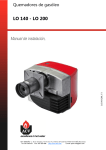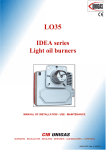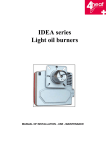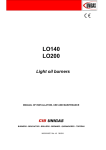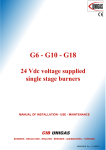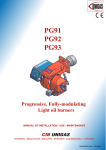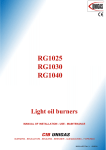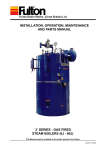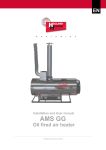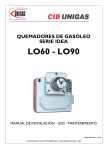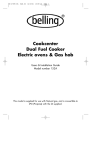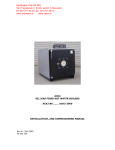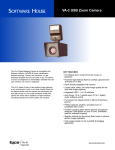Download LO280 - LO400 IDEA Series Light oil Burners
Transcript
LO280 - LO400 IDEA Series Light oil Burners MANUAL OF INSTALLATION - USE - MAINTENANCE BURNERS - BRUCIATORI - BRULERS - BRENNER - QUEMADORES - ГОРЕЛКИ M039134CD Rel. 3.0 03/2010 TABLE OF CONTENTS WARNINGS ................................................................................................................................................................ 3 PART I: INSTALLATION ........................................................................................................................................... 5 Burner model identification ............................................................................................................................................................. 5 Technical Specifications ................................................................................................................................................................. 5 Overall dimensions ......................................................................................................................................................................... 6 Performance curves ........................................................................................................................................................................ 7 How to modify blast tube length ...................................................................................................................................................... 8 MOUNTING AND CONNECTIONS .............................................................................................................................................. 10 Packing ......................................................................................................................................................................................... 10 Fitting the burner to the boiler ....................................................................................................................................................... 10 Electrical connections ................................................................................................................................................................... 11 Installation diagram of light oil pipes ............................................................................................................................................. 12 Pump operating principle .............................................................................................................................................................. 12 Pipeline size .................................................................................................................................................................................. 13 About the use of fuel pumps ......................................................................................................................................................... 13 Connecting the light oil flexible hoses ........................................................................................................................................... 14 SETTINGS ................................................................................................................................................................................... 15 Oil rate adjustment - Single stage burners .................................................................................................................................... 15 Priming the pump .......................................................................................................................................................................... 15 Choosing oil nozzles ..................................................................................................................................................................... 15 Oil rate adjustment - High-low flame burners ................................................................................................................................ 16 Pumps f.......................................................................................................................................................................................... 21 Adjusting the combustion head ..................................................................................................................................................... 21 Adjustments for burners with hydraulic ram .................................................................................................................................. 22 PART II: OPERATION ............................................................................................................................................. 23 OPERATION ................................................................................................................................................................................. 24 Single-stage burners ..................................................................................................................................................................... 24 Double-stage burners ................................................................................................................................................................... 24 Burner control panel ..................................................................................................................................................................... 24 PART III: MAINTENANCE........................................................................................................................................ 25 ROUTINE OPERATIONS ............................................................................................................................................................. 25 Removing the combustion head ................................................................................................................................................... 25 Removing burner components plate ............................................................................................................................................. 26 Assembling burner components plate ........................................................................................................................................... 27 Removing the electrodes .............................................................................................................................................................. 28 Removing the nozzles .................................................................................................................................................................. 29 Correct position of electrodes and combustion head .................................................................................................................... 30 Check the detection current .......................................................................................................................................................... 30 TROUBLESHOOTING .................................................................................................................................................................. 31 BURNER EXPLODED VIEW ....................................................................................................................................................... 32 SPARE PARTS............................................................................................................................................................................. 34 WIRING DIAGRAMS .................................................................................................................................................................... 35 APPENDIX 2 WARNINGS THIS MANUAL IS SUPPLIED AS AN INTEGRAL AND ESSENTIAL PART OF THE PRODUCT AND MUST BE DELIVERED TO THE USER. INFORMATION INCLUDED IN THIS SECTION ARE DEDICATED BOTH TO THE USER AND TO PERSONNEL FOLLOWING PRODUCT INSTALLATION AND MAINTENANCE. THE USER WILL FIND FURTHER INFORMATION ABOUT OPERATING AND USE RESTRICTIONS, IN THE SECOND SECTION OF THIS MANUAL. WE HIGHLY RECOMMEND TO READ IT. CAREFULLY KEEP THIS MANUAL FOR FUTURE REFERENCE. 1) shall have qualified personnel carry out the following operations: a Remove the power supply by disconnecting the power cord from the mains. b) Disconnect the fuel supply by means of the hand-operated shut-off valve and remove the control handwheels from their spindles. GENERAL INTRODUCTION z The equipment must be installed in compliance with the regulations in force, following the manufacturer’s instructions, by qualified personnel. z Qualified personnel means those having technical knowledge in the field of components for civil or industrial heating systems, sanitary hot water generation and particularly service centres authorised by the manufacturer. z Improper installation may cause injury to people and animals, or damage to property, for which the manufacturer cannot be held liable. z Remove all packaging material and inspect the equipment for integrity. In case of any doubt, do not use the unit - contact the supplier. The packaging materials (wooden crate, nails, fastening devices, plastic bags, foamed polystyrene, etc), should not be left within the reach of children, as they may prove harmful. z Before any cleaning or servicing operation, disconnect the unit from the mains by turning the master switch OFF, and/or through the cutout devices that are provided. z Make sure that inlet or exhaust grilles are unobstructed. z In case of breakdown and/or defective unit operation, disconnect the unit. Make no attempt to repair the unit or take any direct action. Contact qualified personnel only. Units shall be repaired exclusively by a servicing centre, duly authorised by the manufacturer, with original spare parts. Failure to comply with the above instructions is likely to impair the unit’s safety. To ensure equipment efficiency and proper operation, it is essential that maintenance operations are performed by qualified personnel at regular intervals, following the manufacturer’s instructions. z When a decision is made to discontinue the use of the equipment, those parts likely to constitute sources of danger shall be made harmless. z In case the equipment is to be sold or transferred to another user, or in case the original user should move and leave the unit behind, make sure that these instructions accompany the equipment at all times so that they can be consulted by the new owner and/or the installer. z For all the units that have been modified or have options fitted then original accessory equipment only shall be used. z This unit shall be employed exclusively for the use for which it is meant. Any other use shall be considered as improper and, therefore, dangerous. The manufacturer shall not be held liable, by agreement or otherwise, for damages resulting from improper installation, use and failure to comply with the instructions supplied by the manufacturer. Special warnings z Make sure that the burner has, on installation, been firmly secured to the appliance, so that the flame is generated inside the appliance firebox. z Before the burner is started and, thereafter, at least once a year, have qualified personnel perform the following operations: a set the burner fuel flow rate depending on the heat input of the appliance; b set the flow rate of the combustion-supporting air to obtain a combustion efficiency level at least equal to the lower level required by the regulations in force; c check the unit operation for proper combustion, to avoid any harmful or polluting unburnt gases in excess of the limits permitted by the regulations in force; d make sure that control and safety devices are operating properly; e make sure that exhaust ducts intended to discharge the products of combustion are operating properly; f on completion of setting and adjustment operations, make sure that all mechanical locking devices of controls have been duly tightened; g make sure that a copy of the burner use and maintenance instructions is available in the boiler room. z In case of a burner shut-down, reser the control box by means of the RESET pushbutton. If a second shut-down takes place, call the Technical Service, without trying to RESET further. z The unit shall be operated and serviced by qualified personnel only, in compliance with the regulations in force. 3) GENERAL INSTRUCTIONS DEPENDING ON FUEL USED 3a) ELECTRICAL CONNECTION z z z z z 2) SPECIAL INSTRUCTIONS FOR BURNERS z z The burner should be installed in a suitable room, with ventilation openings complying with the requirements of the regulations in force, and sufficient for good combustion. z Only burners designed according to the regulations in force should be used. z This burner should be employed exclusively for the use for which it was designed. z Before connecting the burner, make sure that the unit rating is the same as delivery mains (electricity, gas oil, or other fuel). z Observe caution with hot burner components. These are, usually, near to the flame and the fuel pre-heating system, they become hot during the unit operation and will remain hot for some time after the burner has stopped. When the decision is made to discontinue the use of the burner, the user For safety reasons the unit must be efficiently earthed and installed as required by current safety regulations. It is vital that all saftey requirements are met. In case of any doubt, ask for an accurate inspection of electrics by qualified personnel, since the manufacturer cannot be held liable for damages that may be caused by failure to correctly earth the equipment. Qualified personnel must inspect the system to make sure that it is adequate to take the maximum power used by the equipment shown on the equipment rating plate. In particular, make sure that the system cable cross section is adequate for the power absorbed by the unit. No adaptors, multiple outlet sockets and/or extension cables are permitted to connect the unit to the electric mains. An omnipolar switch shall be provided for connection to mains, as required by the current safety regulations. The use of any power-operated component implies observance of a few basic rules, for example: - do not touch the unit with wet or damp parts of the body and/or with bare feet; - do not pull electric cables; - do not leave the equipment exposed to weather (rain, sun, etc.) unless expressly required to do so; - do not allow children or inexperienced persons to use equipment; z The unit input cable shall not be replaced by the user. In case of damage to the cable, switch off the unit and contact qualified personnel to replace. When the unit is out of use for some time the electric switch supplying all the power-driven components in the system (i.e. pumps, burner, etc.) should be switched off. 3 DIRECTIVES AND STANDARDS Gas burners European directives: - Directive 90/396/CEE - Gas Appliances; - Directive 2006/95/EC on low voltage; - Directive 2004/108/CEE on electromagnetic compatibility Harmonised standards : -UNI EN 676 (Gas Burners; -CEI EN 60335-1(Household and similar electrical appliances - Safety. Part 1: General requirements; - EN 50165 (Electrical equipment of non-electric appliances for household and similar purposes. Safety requirements. 3b) FIRING WITH GAS, LIGHT OIL OR OTHER FUELS GENERAL z The burner shall be installed by qualified personnel and in compliance with regulations and provisions in force; wrong installation can cause injuries to people and animals, or damage to property, for which the manufacturer cannot be held liable. z Before installation, it is recommended that all the fuel supply system pipes be carefully cleaned inside, to remove foreign matter that might impair the burner operation. z Before the burner is commissioned, qualified personnel should inspect the following: a the fuel supply system, for proper sealing; b the fuel flow rate, to make sure that it has been set based on the firing rate required of the burner; c the burner firing system, to make sure that it is supplied for the designed fuel type; d the fuel supply pressure, to make sure that it is included in the range shown on the rating plate; e the fuel supply system, to make sure that the system dimensions are adequate to the burner firing rate, and that the system is equipped with all the safety and control devices required by the regulations in force. z When the burner is to remain idle for some time, the fuel supply tap or taps should be closed. Light oil burners European directives: - Directive 2006/95/EC on low voltage; - Directive 2004/108/CEE on electromagnetic compatibility Harmonised standards : -CEI EN 60335-1(Household and similar electrical appliances - Safety. Part 1: General requirements; - EN 50165 (Electrical equipment of non-electric appliances for household and similar purposes. Safety requirements. National standards : -UNI 7824: Monobloc nebulizer burners for liquid fuels. Characteristics and test methods SPECIAL INSTRUCTIONS FOR USING GAS Have qualified personnel inspect the installation to ensure that: a the gas delivery line and train are in compliance with the regulations and provisions in force; b all gas connections are tight; c the boiler room ventilation openings are such that they ensure the air supply flow required by the current regulations, and in any case are sufficient for proper combustion. z Do not use gas pipes to earth electrical equipment. z Never leave the burner connected when not in use. Always shut the gas valve off. z In case of prolonged absence of the user, the main gas delivery valve to the burner should be shut off. Precautions if you can smell gas a do not operate electric switches, the telephone, or any other item likely to generate sparks; b immediately open doors and windows to create an air flow to purge the room; c close the gas valves; d contact qualified personnel. z Do not obstruct the ventilation openings of the room where gas appliances are installed, to avoid dangerous conditions such as the development of toxic or explosive mixtures. Heavy oil burners European directives: - Directive 2006/95/EC on low voltage; - Directive 2004/108/CEE on electromagnetic compatibility Harmonised standards : -CEI EN 60335-1 Household and similar electrical appliances - SafetyPart 1: General requirements; - EN 50165 Electrical equipment of non-electric appliances for household and similar purposes. Safety requirements. National standards : -UNI 7824: Monobloc nebulizer burners for liquid fuels. Characteristics and test methods Gas - Light oil burners European directives: - Directive 90/396/CEE Gas Appliances; - Directive 2006/95/EC on low voltage; - Directive 2004/108/CEE on electromagnetic compatibility Harmonised standards : -UNI EN 676 Gas Burners -CEI EN 60335-1(Household and similar electrical appliances - Safety. Part 1: General requirements; - EN 50165 Electrical equipment of non-electric appliances for household and similar purposes. Safety requirements. National standards : -UNI 7824: Monobloc nebulizer burners for liquid fuels. Characteristics and test methods Gas - Heavy oil burners European directives: - Directive 90/396/CEE - Gas Appliances; - Directive 2006/95/EC on low voltage; - Directive 2004/108/CEE on electromagnetic compatibility Harmonised standards : -UNI EN 676 (Gas Burners; -CEI EN 60335-1(Household and similar electrical appliances - Safety. Part 1: General requirements; - EN 50165 Electrical equipment of non-electric appliances for household and similar purposes. Safety requirements. National standards : -UNI 7824: Monobloc nebulizer burners for liquid fuels. Characteristics and test methods 4 C.I.B. UNIGAS - M039134CD PART I: INSTALLATION Burner model identification Burners are identified by burner type and model. Burner model identification is described as follow. Type LO400 Model (1) G-. AB. S. (2) (3) (4) *. A. (1) BURNER TYPE (5) (6) LO550 (2) FUEL G - Light oil A - Biodiesel (3) OPERATION(Available versions) (4) BLAST TUBE (5) DESTINATION COUNTRY TN - Single-stage AB - Double-stage S - Standard L - Extended * - see data plate (6) BURNER VERSION A - Standard M - With hydraulic ram Technical Specifications BURNERS Output LO280 G-.TN.... LO280 G-.AB.... 115 - 310 70 - 310 Light oil Light oil min. - max. kW Fuel Light oil rate min.- max. kg/h - Viscosity Density 9.6 - 26 2 - 7.4 kg / m3 0.84 Power supply Electric motor 5.8 - 26 cSt @ 40°C 230V 50Hz kW 0.25 0.25 Total power consumption W 0.55 0.55 Weight kg 42 Single stage 42 Double stage Operation Operating temperature °C -10 ÷ +50 Storage Temperature °C -20 ÷ +60 Intermittent Working service* BURNERS Output LO400 G-.TN.... LO400 G-.AB.... 195 - 420 115 - 420 Light oil Light oil min.-max.kW Fuel Light oil rate Viscosity Density min. - max. kg/h 16 - 35 10 - 35 cSt @ 40°C 2 - 7.4 kg / m3 0.84 Power supply 230V 50Hz Electric motor kW 0.37 0.37 Total power consumption W 0.67 0.67 Weight kg 42 Single stage 42 Double stage Operation Operating temperature °C -10 ÷ +50 Storage Temperature °C -20 ÷ +60 Intermittent Working service* NOTE: Choosing the nozzle for light oil, consider Hi equal to 42.74MJ/kg. *NOTE ON THE BURNER WORKING SERVICE: Burners provided with Siemens LOA24 control box: for safety reasons, one controlled shutdown must take place every 24 hours. z Burners provided with Siemens LMO24-44 control box: the control box automatically stops after 24h of continuous working. The control box immediately starts up, automatically. z WARNING: if fuel used is BIODIESEL, some components must be replaced. Please contact our Technical Department for further details. 5 Y Overall dimensions (mm) G O max. O min. K2 L N P H O max. O min. X P M K1 T B F O Boiler recommended drilling template and burner flange 6 LO280 LO400 A(S*) 733 748 A(L*) 878 878 B(S*) 163 178 B(L*) 308 308 C 570 570 F 396 396 G 108 125 H 128 164 K1 215 215 K2 223 223 L 348 348 *S = measure referred to burners fitted with standard blast tube *L = measure referred to burners fitted with extended blast tube As far as modifying the blast tube length for mod. (LO400) see paragraph “How to modify the the blast tube length”. M M10 M10 N Omin Omax P 219 131 179 155 219 131 179 155 T 128 89 X 491 491 Y 108 144 C.I.B. UNIGAS - M039134CD C A C.I.B. UNIGAS - M039134CD Performance curves BACK PRESSURE IN CCOMBUSTION CHAMBER mbar LO280 Single stage LO280 High-Low flame 6 6 5 5 4 4 3 3 2 2 1 0 100 1 150 200 250 300 350 50 100 150 200 250 300 LO400 High-Low flame 8 7 6 9 8 7 6 5 4 3 2 1 0 -1 100 5 4 3 2 1 0 -1 150 200 250 350 kW kW LO400 Single stage BACK PRESSURE IN CCOMBUSTION CHAMBER mbar 0 300 350 400 450 150 200 250 300 kW 350 400 450 kW To get the input in kcal/h, multiply value in kW by 860. Data are referred to standard conditions: atmospheric pressure at 1013mbar, ambient temperature at 15°C NOTE: The performance curve is a diagram that represents the burner performance in the type approval phase or in the laboratory tests, but does not represent the regulation range of the machine. On this diagram the maximum output point is usually reached by adjsuting the combustion head to its “MAX” position (see paragraph “Adjusting the combustion head”); the minimum output point is reached setting the combustion head to its “MIN” position. During the first ignition, the combustion head is set in order to find a compromise between the burner output and the generator specifications, that is why the minimum output may be different from the Performance curve minimum. 7 C.I.B. UNIGAS - M039134CD How to modify blast tube length (mod. LO400) To modify blast tube length please read the following instructions. 1 Remove combustion head (See “Removing the combustion head” - Part III of this user’s manual). 2 Remove the flanged piece T by removing the 4 socket head screws VTF (Fig. 4). 3 Remove the 4 screws which hold the blast tube to the flanged piece (Fig. 5). 4 Extract the blast tube from the flanged piece and assemble it in the other way round as shown in pictures Fig. 6 and Fig. 7. Now fasten the two pieces using the same screws (Fig. 8). 5 Assemble the whole piece to the burner, paying attention to the indication in picture Fig. 9. T VTF Fig. 4 Fig. 5 Fig. 6 - Short blast tube Fig. 7 - Long blast tube Fig. 8 Fig. 9 If you modify the blast tube length you have to modify also the combustion head length by reading the following instructions: 1 Loosen the light oil feeding pipes connected to the nozzle-holder by using two spanners size 22 and 10 (Fig. 10). 2 Adjust cables length by pulling them very slightly as shown in Fig. 11. 3 Loosen the screw VA which tights the rod A (Fig. 12) and shift backward the flange as shown. 4 Tight the screw in the backward hole on the rod, see picture Fig. 13. 5 Fix the two extensions (supplied along with the burner inside the accessories carton box) on the light oil feeding pipes (Fig. 14) and tight them by using two spanners size 13 and 10 (Fig. 15). Fix the extensions to the nozzle holder by using two spanners size 22 and 10 (Fig. 15). 8 C.I.B. UNIGAS - M039134CD 6 Assemble again the combustion head (See “Removing the combustion head” - Part III of this user’s manual). 22 VA A 10 Fig. 10 Fig. 11 Fig. 12 13 10 Fig. 13 Fig. 14 9 Fig. 15 C.I.B. UNIGAS - M039134CD MOUNTING AND CONNECTIONS Packing The burners are despatched in packages of dimensions 795 x 550 x 490 mm (W x H x D). Packing cases of this kind are affected by humidity; the maximum number of cases to be stacked is indicated outside the packing . The following are placed in each packing case: z burner; z light oil flexible hoses; z light oil filter; z gasket to be inserted between the burner and the boiler; z envelope containing this manual. To get rid of the burner’s packing and in the event of scrapping of the latter, follow the procedures laid down by current laws on disposal of materials. Fitting the burner to the boiler To perform the installation, proceed as follows: 1 place the 4 stud bolts on the hole of the boiler’s door, according to the burner’s drilling plate described on paragraph “Overall dimensions”; 2 place the gasket on the burner’s flange; 3 install the burner into the boiler; 4 fix the burner to the stud bolts, by means of the fixing nuts, according to Fig. 16. 5 After fitting the burner to the boiler, ensure that the gap between the blast tube and the refractory lining is sealed with appropriate insulating material (ceramic fibre cord or refractory cement). Key 1 Burner 2 Fixing nut 3 Washer 4 Sealing gasket 5 Stud bolt 7 Blast tube 10 Fig. 16 C.I.B. UNIGAS - M039134CD Electrical connections ATTENTION: PLEASE READ CAREFULLY THE “WARNINGS” CHAPTER, AT THE BEGINNIG OF THIS MANUAL. Identification of linking connectors HIGH/LOW flame connector (CONN-TAB - Fig. 20) - mod. LO400 Fig. 17 Burner power supply connector (CONN-LINEA - Fig. 19) Fig. 18 IMPORTANT: before operating the burner, be sure all connectors are linked as indicated in the diagrams. Make the electric connections following the diagrams below. WARNING: the burner is fitted with a bridge between terminals T6 and T8 on CN2-TAB connector (external side link, male connector); remove this bridge before thermostat connection. Fig. 20: High - Low flame burners Fig. 19: Single stage burners Key C1-C2 LAF Time counter Burner in high flame signalling lamp (high-low flame and progressive versions only) CONN-LINEAConnectors on electrical board LB Burner lockout signalling lamp CONN-TABConnectors on electrical board LBF Burner in low flame signalling lamp (high-low flame and progressive versions only) F1-F3 Fuses IL Line switch for burner’s auxiliaries N Neutral IM Fan motor line switch ST Thermostats or pressure switches group L Phase TAB High-Low flame thermostat TS Boiler safety thermostat 11 C.I.B. UNIGAS - M039134CD Installation diagram of light oil pipes PLEASE READ CAREFULLY THE “WARNINGS” CHAPTER AT THE BEGINNING OF THIS MANUAL. From tank To tank Fig. 21 - Double-pipe system The burner is supplied with filter and flexible hoses, all the parts upstream the filter and downstream the return flexible hose, must be installed by the customer. As far as the hoses connection, see the related paragraph. (*) Only for installations with gravity, siphon or forced circulation feed systems. If the device installed is a solenoid valve, a timer must be installed to delay the valve closing. The direct connection of the device without a timer may cause pump breaks. Key 1 Burner 2 Flexible hoses (fitted) 3 Light oil filter (fitted) 4 Automatic interceptor (*) 5 One-way valve (*) 6 Gate valve 7 Quick-closing gate-valve (outside the tank or boiler rooms) Pump operating principle In the burners, the mixture bertween oil and air, to perform a clean and efficient combustion, is activated by atomization of oil into very small particles. This process is achieved making oil passing through the nozzle at a determined pressure The pump’s main function is to transfer oil from the tank to the nozzle in the desired quantity and pressure. To adjust this pressure, pumps are provided with a pressure regulator (except for some models for which a separate regulating valve is provided). Other pumps are provided with two pressure regulators: one for the high and one for low pressure (in tow-stage systems with one nozzle). These pumps can be installed both into single-pipe and double-pipe systems. Single-pipe system: a single pipe drives the oil from the tank to the pump’s inlet. Then, from the pump, the pressurised oil is driven to the nozzle: a part comes out from the nozzle while the othe part goes back to the pump. In this system, the by-pass pulg, if provided, must be removed and the optional return port, on the pump’s body, must be sealed by steel plug and washer. Double-pipe system: as for the single pipe system, a pipe that connects the tank to the pump’s inlet is used besides another pipe that connects the pum’s return port to the tank, as well. The excess of oil goes back to the tank: this installation can be considered self-bleeding. If provided, the inside by-pass plug must be installed to avoid air and fuel passing through the pump. Burners come out from the factory provided for double-stage systems. They can be suited for single-pipe system (recommended in the case of gravity feed) as decribed before. Bleed Bleeding in two-pipe operation is automatic : it is assured by a bleed flat on the piston. In one-pipe operation, the plug of a pressure gauge port must be loosened until the air is evacuated from the system. 12 C.I.B. UNIGAS - M039134CD Pipeline size As far as the pipes installation, refer to the following values, considering as well, the plant’s needs. Syphon twin pipe feed Twin pipe suction feed Fig. 22 Fig. 23 SUNTEC AL65 - AS47 - AT2 45 SUNTEC AL65 - AS47 - AT2 45 H (m) 0 0,5 1 2 3 4 L (m) ø6 14 16 18 22 25 29 ø8 49 55 61 73 85 96 ø10 123 136 150 150 150 150 H (m) ø12 150 150 150 150 150 150 0 0,5 1 2 3 4 L (m) ø6 14 12 10 7 3 0 ø8 49 44 38 26 13 1 ø10 123 110 96 66 13 1 ø12 150 150 150 140 75 15 L= Maximum pipeline length in meters, according to its size and the tank positioning. About the use of fuel pumps z z z z z z z z Make sure that the by-pass plug is not used in a single pipe installation, because the fuel unit will not function properly and damage to the pump and burner motor could result. Do not use fuel with additives to avoid the possible formation over time of compounds which may deposit between the gear teeth, thus obstructing them. After filling the tank, wait before starting the burner. This will give any suspended impurities time to deposit on the bottom of the tank, thus avoiding the possibility that they might be sucked into the pump. On initial commissioning a "dry" operation is foreseen for a considerable length of time (for example, when there is a long suction line to bleed). To avoid damages inject some lubrication oil into the vacuum inlet. Care must be taken when installing the pump not to force the pump shaft along its axis or laterally to avoid excessive wear on the joint, noise and overloading the gears. Pipes should not contain air pockets. Rapid attachment joint should therefore be avoided and threaded or mechanical seal junctions preferred. Junction threads, elbow joints and couplings should be sealed with removable sg component. The number of junctions should be kept to a minimum as they are a possible source of leakage. Do not use PTFE tape on the suction and return line pipes to avoid the possibility that particles enter circulation. These could deposit on the pump filter or the nozzle, reducing efficiency. Always use O-Rings or mechanical seal (copper or aluminium gaskets) junctions if possible. An external filter should always be installed in the suction line upstream of the fuel unit. 13 C.I.B. UNIGAS - M039134CD Connecting the light oil flexible hoses To connect the flexible hoses to the pump, proceed as follows. 1 Remove burner’s cover. 2 Remove the light oil pump delivery and return line plugs A and B. mod. LO280 A B Fig. 24 3 4 Fig. 25 mod. LO400 D D F F Fig. 26 Screw the rotating nut D of the two flexible hoses F on the pump being careful to avoid inverting the delivery and return lines. Fix the flexible hoses as showed on Fig. 27. Fig. 27 5 Replace burner cover. WARNING: if fuel used is BIODIESEL, some components must be replaced. Please contact our Technical Department for further details. 14 C.I.B. UNIGAS - M039134CD SETTINGS LO280 Oil rate adjustment - Single stage burners Priming the pump Prior to start up the burner, make sure that the return pipe to the tank is not obstructed. Any obstruction would cause the pump seal to break. Before carrying out the adjustment it is necessary to start up the fuel pump, proceeding as follows: 1 remove the burner cover; 2 start the burner up, by turning the main switch to on; 3 make the thermostat ST contacts close; 4 wait for the solenoid valve to open; 5 remove the photoresistor and light it up; 6 bleed the air from the pressure gauge port (see paragraph “Light oil pumps”). If the burner locks, press the unlock pushbutton of the burner and repeat the steps above. The fuel flow rate is set choosing a properly dimensioned nozzle and setting the inlet pressure on the pump (see the hydraulic diagram in ). To choose the correct nozzle refer to Tab. 1, for the setting of the pump pressure, see pag. 21. Note: all pumps are set to 12 bar. The nozzle rate must be higher than the rate referred to the minimum burner output. Choosing oil nozzles Key EVG Light oil solenoid valve M Manometer P Pump (see chapter “LIGHT OIL PUMPS”)) Fig. 28 P M EVG Tab. 1 - Single stage burners NOZZLE PUMP PRESSURE (bar) 6 7 8 9 10 G.P.H. 11 12 13 14 kg/h 1,35 3,97 4,29 4,59 4,86 5,13 5,38 5,62 5,85 6,07 1,50 4,41 4,77 5,10 5,41 5,70 5,98 6,24 6,50 6,74 1,65 4,85 5,24 5,61 5,95 6,27 6,57 6,87 7,15 7,42 1,75 5,15 5,56 5,95 6,31 6,65 6,97 7,28 7,58 7,87 2,00 5,88 6,36 6,80 7,21 7,60 7,97 8,32 8,66 8,99 2,25 6,62 7,15 7,64 8,11 8,55 8,96 9,36 9,74 10,11 2,50 7,36 7,95 8,49 9,01 9,50 9,96 10,40 10,83 11,24 3,00 8,83 9,53 10,19 10,81 11,40 11,95 12,48 12,99 13,48 3,50 10,30 11,12 11,89 12,61 13,29 13,94 14,56 15,16 15,73 4,00 11,77 12,71 13,59 14,41 15,19 15,94 16,64 17,32 17,98 4,50 13,24 14,30 15,29 16,22 17,09 17,93 18,72 19,49 20,23 5,00 14,71 15,89 16,99 18,02 18,99 19,92 20,81 21,65 22,47 5,50 16,18 17,48 18,69 19,82 20,89 21,91 22,89 23,82 24,72 6,00 17,65 19,07 20,39 21,62 22,79 23,90 24,97 25,99 26,97 6,50 19,13 20,66 22,08 23,42 24,69 25,90 27,05 28,15 29,21 15 C.I.B. UNIGAS - M039134CD Oil rate adjustment - High-low flame burners Priming the pump Prior to start up the burner, make sure that the return pipe to the tank is not obstructed. Any obstruction would cause the pump seal to break. Before carrying out the adjustment it is necessary to start up the fuel pump, proceeding as follows: 1 remove the burner cover; 2 start the burner up, by turning the main switch to on; 3 make the thermostat ST contacts close; 4 wait for the solenoid valve to open; 5 remove the photoresistor and light it up; 6 bleed the air from the pressure gauge port (see paragraph “Light oil pumps”). If the burner locks, press the unlock pushbutton of the burner and repeat the steps above. The light oil flow rate is adjusted choosing a nozzle of proper dimensions and setting the inlet pump pressure. To choose the nozzle refer to the table below. Setting the light oil pump Adjust the ignition stage of the pump, to a pressure value of 8 - 10 bar. After 10”, the safety device switch to the second stage. The pump setting must be fixed to 24 bar, by means of the adjusting screw (see chapter “LIGHT OIL PUMPS”). NOTE: The nozzle oil rate at a pressure of 8 bar, must be greather than the oil rate at the minimum output. Regulator high flame Regulator low flame low flame: 8÷10 bar high flame: 24 bar NOZZLE G.P.H. 0,40 0,50 0,60 0,65 0,75 0,85 1,00 1,10 1,20 1,25 1,35 1,50 1,65 1,75 2,00 2,25 2,50 3,00 3,50 4,00 4,50 8 9 10 11 12 13 14 1,36 1,70 2,04 2,21 2,55 2,89 3,40 3,74 4,08 4,25 4,59 5,10 5,61 5,95 6,80 7,64 8,49 10,19 11,89 13,59 15,29 1,44 1,80 2,16 2,34 2,70 3,06 3,60 3,96 4,32 4,50 4,86 5,41 5,95 6,31 7,21 8,11 9,01 10,81 12,61 14,41 16,22 1,52 1,90 2,28 2,47 2,85 3,23 3,80 4,18 4,56 4,75 5,13 5,70 6,27 6,65 7,60 8,55 9,50 11,40 13,29 15,19 17,09 1,59 1,99 2,39 2,59 2,99 3,39 3,98 4,38 4,78 4,98 5,38 5,98 6,57 6,97 7,97 8,96 9,96 11,95 13,94 15,94 17,93 1,66 2,08 2,50 2,70 3,12 3,54 4,16 4,58 4,99 5,20 5,62 6,24 6,87 7,28 8,32 9,36 10,40 12,48 14,56 16,64 18,72 1,73 2,17 2,60 2,82 3,25 3,68 4,33 4,76 5,20 5,41 5,85 6,50 7,15 7,58 8,66 9,74 10,83 12,99 15,16 17,32 19,49 1,80 2,25 2,70 2,92 3,37 3,82 4,49 4,94 5,39 5,62 6,07 6,74 7,42 7,87 8,99 10,11 11,24 13,48 15,73 17,98 20,23 PUMP PRESSURE (bar) 15 16 17 18 kg/h 1,86 1,92 1,98 2,04 2,33 2,40 2,48 2,55 2,79 2,88 2,97 3,06 3,02 3,12 3,22 3,31 3,49 3,60 3,71 3,82 3,95 4,08 4,21 4,33 4,65 4,80 4,95 5,10 5,12 5,29 5,45 5,61 5,58 5,77 5,94 6,12 5,82 6,01 6,19 6,37 6,28 6,49 6,69 6,88 6,98 7,21 7,43 7,64 7,68 7,93 8,17 8,41 8,14 8,41 8,67 8,92 9,30 9,61 9,91 10,19 10,47 10,81 11,14 11,47 11,63 12,01 12,38 12,74 13,96 14,41 14,86 15,29 16,28 16,82 17,33 17,84 18,61 19,22 19,81 20,39 20,94 21,62 22,29 22,93 Tab. 2 - Choice of the oil nozzle - High-low flame burners 16 19 20 21 22 23 24 25 2,09 2,62 3,14 3,40 3,93 4,45 5,24 5,76 6,28 6,54 7,07 7,85 8,64 9,16 10,47 11,78 13,09 15,71 18,33 20,94 23,56 2,15 2,69 3,22 3,49 4,03 4,57 5,37 5,91 6,45 6,71 7,25 8,06 8,86 9,40 10,74 12,09 13,43 16,12 18,80 21,49 24,17 2,20 2,75 3,30 3,58 4,13 4,68 5,50 6,06 6,61 6,88 7,43 8,26 9,08 9,63 11,01 12,39 13,76 16,51 19,27 22,02 24,77 2,25 2,82 3,38 3,66 4,23 4,79 5,63 6,20 6,76 7,04 7,61 8,45 9,30 9,86 11,27 12,68 14,09 16,90 19,72 22,54 25,35 2,30 2,88 3,46 3,74 4,32 4,90 5,76 6,34 6,91 7,20 7,78 8,64 9,51 10,08 11,52 12,96 14,40 17,28 20,16 23,04 25,92 2,35 2,94 3,53 3,83 4,41 5,00 5,88 6,47 7,06 7,36 7,94 8,83 9,71 10,30 11,77 13,24 14,71 17,65 20,60 23,54 26,48 2,40 3,00 3,60 3,90 4,50 5,11 6,01 6,61 7,21 7,51 8,11 9,01 9,91 10,51 12,01 13,51 15,02 18,02 21,02 24,02 27,03 C.I.B. UNIGAS - M039134CD mod. LO280 Air rate setting z Single stage burners 1 2 loosen VR screw. move the ID index along the graduated slot towards + or -, in order to increase or decrease the air flow-rate, according to the required combustion values. fasten the VR screw again. 3 ID VR Fig. 29 z Double stage burners Adjusting the actuator cams Refer to the next table for cams functions. Berger STA4.5 Siemens SQN72 I IV II II III I AUTO/MAN VS BERGER STA Siemens SQN72 ”Air adjustment in high flame” cam I I (red) Air adjustment in low flame - Stand-by - Ignition cam II II (blue) EVG2 opening (2nd nozzle) III IV (black) z z Berger STA12: this actuator is not provided with the manual control of the air damper. The adjustment of the cams is carried out by means of a screwdriver, by twisting the VS screw located inside the cam. Siemens SQN72: a key is provided to move cams I and IV, the other cams can be moved by means of screws. On the Siemens actuator the AUTO/MAN mode is provided (see picture). During the first setting, set the cam III (Berger) / IV (Siemens) between the cams I and II. Then, passing from the low to high flame stage, or viceversa, change the setting according to the flame composition: if cam III is too near to the low flame position (cam II), flue gas can take place, because there is more fuel than air; if cam III is too near to the high flame (cam I), the flame could fade because of too much air. . 17 C.I.B. UNIGAS - M039134CD MOD. LO400 SETTINGS Priming the pump Prior to start up the burner, make sure that the return pipe to the tank is not obstructed. Any obstruction would cause the pump seal to break. Before carrying out the adjustment it is necessary to start up the fuel pump, proceeding as follows: 1 remove the burner cover; 2 start the burner up, by turning the main switch to on; 3 make the thermostat ST contacts close; 4 wait for the solenoid valve to open; 5 remove the photoresistor and light it up; 6 bleed the air from the pressure gauge port (see paragraph “Light oil pumps”). If the burner locks, press the unlock pushbutton of the burner and repeat the steps above. Fuel rate adjustment The fuel rate is setting choosing properly sized nozzles and adjusting the fuel pressure at the pump inlet (see the diagram Fig. 30 and Fig. 31). To choose the nozzles refer to Tab. 3 and Tab. 4; for pump pressure regulation see on pag. 21. For further information on fuel pump see also the appendix. Note: all pumps are set to 12 bar. The nozzle rate must be higher than the rate referred to the minimum burner output. Fig. 30 - Single stage burners Fig. 31 - Double stage burners EVG2 P M EVG1 EVG Key EV EVG2 Fuel solenoid valve - 2nd stage (only hi-lo flame burners) Fuel solenoid valve M Manometer EVG1 Fuel solenoid valve - low flame P Pump Choosing the light oil nozzles Tab. 3 LO400 Single-stage 10 NOZZLE (G.P.H.) 4,00 4,50 5,00 5,50 6,00 6,50 7,00 7,50 8,30 9,50 15,19 17,09 18,99 20,89 22,79 24,69 26,59 28,49 31,53 36,09 PUMP PRESSURE (bar) 12 FUEL RATE kg/h 16,64 18,72 20,81 22,89 24,97 27,05 29,13 31,21 34,54 39,53 18 14 17,98 20,23 22,47 24,72 26,97 29,21 31,46 33,71 37,30 42,70 C.I.B. UNIGAS - M039134CD Tab. 4 LO400 -Double-stage RATE OUTPUT PUMP PRESSURE kg/h kcal/h kW 10bar 12bar 14bar 30 306.300 356 3.50+4.50 3.00+4.00 3.00+3.50 35 357.350 416 4.00+5.00 3.50+5.00 3.50+4.00 40 408.400 475 4.50+6.00 4.00+5.50 4.00+5.00 45 459.450 534 5.00+6.50 4.50+6.00 4.00+6.00 50 510.500 594 5.50+7.50 5.00+7.00 4.50+6.50 First start and air rate setting (MOD. LO400) Single stage burners Set the air rate working on the screw VBS (Fig. 32); screw to decrease the air rate or unscrew to increase it. Double-stage burners z The air flow can be adjusted using the air damper servo-control cams as follows. z Remove the burner cover cover. z Remove the actuator cover. z Start the burner and let it burn at low flame (remove the bridge between terminals T6 and T8). z Adjust the air flow in low flame by working on the proper cam (page 20). z Prime the second nozzle using the following procedure: z Start the burner z When the flame appears press the P1 button (Fig. 33) for a few seconds to fill the second nozzle pipe; z The cycle continues, and if the TAB thermostat is connected, the flame control box brings the burner to high flame. If the TAB thermostat is not connected, bridge Terminals T6 and T8 on the connector (see pag. 11). Adjust the air flow at high flame by working on the appropriate cam. z The cam that enables the opening of the 2nd stage fuel valve (valve EVG2) must be set in an intermediate position between the other two cams. z Replace the cover on the actuator. z Replace the burner cover. VBS Fig. 32 P1 Fig. 33 - - Second nozzle ignition pushbutton on double stage burners Connections for pressure measurement Combustion chamber pressure port Fan air pressure port 19 C.I.B. UNIGAS - M039134CD Adjusting the actuator cams Refer to the next table for cams functions. Berger STA4.5 Siemens SQN72 I IV II II III I AUTO/MAN VS BERGER STA Siemens SQN72 ”Air adjustment in high flame” cam I I (red) Air adjustment in low flame - Stand-by - Ignition cam II II (blue) III IV (black) EVG2 opening (2nd nozzle) z z Berger STA12: this actuator is not provided with the manual control of the air damper. The adjustment of the cams is carried out by means of a screwdriver, by twisting the VS screw located inside the cam. Siemens SQN72: a key is provided to move cams I and IV, the other cams can be moved by means of screws. On the Siemens actuator the AUTO/MAN mode is provided (see picture). During the first setting, set the cam III (Berger) / IV (Siemens) between the cams I and II. Then, passing from the low to high flame stage, or viceversa, change the setting according to the flame composition: if cam III is too near to the low flame position (cam II), flue gas can take place, because there is more fuel than air; if cam III is too near to the high flame (cam I), the flame could fade because of too much air. mod. LO280 Pumps Pump Suntec AS47 A Viscosity Fuel temperature Maximum inlet pressure 2 ÷ 12 mm²/s (cSt) 0 ÷ 60 °C 2 bar Minimum inlet pressure Maximum Return pressure Maximum speed - 0.45 bar to avoid gasing 2 bar 3600 rpm Pump Suntec AT2 45A Viscosity range Oil temperature max Inlet pressure 2 ÷ 12 (cSt) mm2/s 60 °C 2 bar Maximum return pressure Maximum speed - 0.35 barto avoid gasing 2 bar 3600 rpm Keys for Suntec AS47 A pump 1 Pressure governor 2 Manometer 3 Vacuum gauge 4 Solenoid valve 5 Nozzle outlet 7 Suction 8 Return Keys for Suntec A T2 45A pump 1 Low pressure regulation (first stage) 2 Manometer 3 Vacuum gauge 4 Light oil solenoid valve 4a High-low pressure solenoid valve 5 Nozzle outlet 6 High pressure regulation (second stage) 7 Suction 8 Return (with internal by-pass plug) 20 C.I.B. UNIGAS - M039134CD Pumps for mod. LO400 Pump Suntec AL65 Viscosity range Oil temperature Inlet pressure 2 ÷ 12 (cSt) mm2/s 0 ÷ 60 °C 2 bar Minimum inlet pressure Maximum return pressure Rated speed - 0,45 barto avoid gasing 2 bar 3600 rpm Keys 1 inlet (suction) G1/4 2 return and internal by-pass plug G1/4 3 outlet to the nozzle G1/8 4 pressure gauge port G1/8 5 vacuum gauge port G1/8 6 pressure adjusting screw ADJUSTING THE COMBUSTION HEAD The burner is set in the factory with the combustion head in the "MAX" position, corresponding to the maximum power (combustion head all-forward). To operate the burner at a lowest strenght, progressively shift back the combustion head, toward the "MIN" position, rotating the VRT screw clockwise (Fig. 34-Fig. 35). LO280 LO400 MIN MIN VRT VRT MAX MAX Fig. 34 Fig. 35 21 C.I.B. UNIGAS - M039134CD Adjustments for burners with hydraulic ram High flame air regulation + 4 Low flame air regulation - 3 + 2 - 1 Hydraulic ram for air damper control Air setting (the low flame air setting must be carried out first) a) Low flame setting To set the low flame, proceed as follow. z Break off the contact of the second stage regulator, unloose the locking nut (2) and turn directly the body of the hydraulic ram (1). Turn clockwise to increase the air flow of the low flame stage; turn counterclockwise to decrease the air flow. z At the end of settings, tight again the nut (2). b) High flame setting To set the high flame, proceed as follow. z Close the contact of the second stage regulator and unloose the nut (3); turn the nut (4). Turning counterclockwise the high flame air flow is increased, turning clockwise the air flow is decreased. z At the end of settings, tight again the nut (3). NOTICE: during the step b regulations, the step a settings remain unchanged. 22 C.I.B. UNIGAS - M039134CD PART II: OPERATION LIMITATIONS OF USE THE BURNER IS AN APPLIANCE DESIGNED AND CONSTRUCTED TO OPERATE ONLY AFTER BEING CORRECTLY CONNECTED TO A HEAT GENERATOR (E.G. BOILER, HOT AIR GENERATOR, FURNACE, ETC.), ANY OTHER USE IS TO BE CONSIDERED IMPROPER AND THEREFORE DANGEROUS. THE USER MUST GUARANTEE THE CORRECT FITTING OF THE APPLIANCE, ENTRUSTING THE INSTALLATION OF IT TO QUALIFIED PERSONNEL AND HAVING THE FIRST COMMISSIONING OF IT CARRIED OUT BY A SERVICE CENTRE AUTHORISED BY THE COMPANY MANUFACTURING THE BURNER. A FUNDAMENTAL FACTOR IN THIS RESPECT IS THE ELECTRICAL CONNECTION TO THE GENERATOR’S CONTROL AND SAFETY UNITS (CONTROL THERMOSTAT, SAFETY, ETC.) WHICH GUARANTEES CORRECT AND SAFE FUNCTIONING OF THE BURNER. THEREFORE, ANY OPERATION OF THE APPLIANCE MUST BE PREVENTED WHICH DEPARTS FROM THE INSTALLATION OPERATIONS OR WHICH HAPPENS AFTER TOTAL OR PARTIAL TAMPERING WITH THESE (E.G. DISCONNECTION, EVEN PARTIAL, OF THE ELECTRICAL LEADS, OPENING THE GENERATOR DOOR, DISMANTLING OF PART OF THE BURNER). NEVER OPEN OR DISMANTLE ANY COMPONENT OF THE MACHINE. OPERATE ONLY THE MAIN SWITCH, WHICH THROUGH ITS EASY ACCESSIBILITY AND RAPIDITY OF OPERATION ALSO FUNCTIONS AS AN EMERGENCY SWITCH, AND ON THE RESET BUTTON. IN CASE OF A BURNER SHUT-DOWN, RESET THE CONTROL BOX BY MEANS OF THE RESET PUSHBUTTON. IF A SECOND SHUT-DOWN TAKES PLACE, CALL THE TECHNICAL SERVICE, WITHOUT TRYING TO RESET FURTHER. WARNING: DURING NORMAL OPERATION THE PARTS OF THE BURNER NEAREST TO THE GENERATOR (COUPLING FLANGE) CAN BECOME VERY HOT, AVOID TOUCHING THEM SO AS NOT TO GET BURNT. 23 C.I.B. UNIGAS - M039134CD OPERATION Single-stage burners z z z z z z Turn on the burner using the switch A on the control panel (: the control panel of the single stage burner is only provided with the power switch and the fuse). Make sure that the control box is not in shutdown condition and if so, release by using the release button S on the burner cover (see Fig. 37). Make sure that the set of thermostats (or pressure-switches) enables burner operation. The burner starting cycle begins and the control box starts the burner fan while the ignition transformer switches on at the same time. At the end of pre-ventilation, the fuel solenoid valve receives input and the burner switches on. The ignition transformer remains switched on for a few seconds after the ignition of the flame (post-ignition time) after which it is disconnected from the circuit. Double-stage burners z z z z z z z Turn on the burner using the switch A on the control panel (Fig. 36). Make sure that the control box is not in shutdown condition and if so, release by using the release button S on the burner cover (see Fig. 37). Make sure that the set of thermostats (or pressure-switches) enables burner operation. The burner starting cycle begins and the control box starts the burner fan while the ignition transformer switches on at the same time; pre-ventilation lasts for 13 or 25 seconds depending on the control box provided with the burner. At the end of pre-ventilation, the fuel solenoid valve (1st stage, EVG1) receives input as signalled by the illumination of the signal light H on the control panel and the burner starts. The ignition transformer remains switched on for a few seconds after the ignition of the flame (post-ignition time), after which it is disconnected from the circuit and the corresponding signal light switches off. In this way, the burner is lit at low flame; after 5 or 15 seconds (depending on the control box installed) two-stage operation begins and the burner is either automatically brought to high flame (light G on) or remains burning at low flame (light H on) depending on the requests received from the system. Burner control panel Keys A E B C D A G H F Fig. 36 S Fig. 37 24 Main switch B High flame lamp C Low flame lamp D Ignition transformer ligh E Lockout signalling lamp F Fuse G High flame solenoid valve operation light H Low flame solenoid valve operation light S Reset pushbutton (Fig. 37) C.I.B. UNIGAS - M039134CD PART III: MAINTENANCE At least once a year carry out the maintenance operations listed below. In the case of seasonal servicing, it is recommended to carry out the maintenance at the end of each heating season; in the case of continuous operation the maintenance is carried out every 6 months. WARNING: ALL OPERATIONS ON THE BURNER MUST BE CARRIED OUT WITH THE MAINS DISCONNECTED AND THE FUEL MANAUL CUTOFF VALVES CLOSED! ATTENTION: READ CAREFULLY THE “WARNINGS” CHAPTER AT THE BEGINNIG OF THIS MANUAL.. PLEASE, READ CAREFULLY “WARNINGS” CHAPTER, AT THE BEGINNING OF THIS MANUAL. ROUTINE OPERATIONS z z z z z z Inspection and cleaning of the light oil filter cartdrige; replace it if necessary. Check the overall condition of the flexible light oil hoses and make sure there are no signs of leakage; Inspection and cleaning of the filter inside the light oil pump: filter must be thoroughly cleaned at least once in a season to ensure correct working of the fuel unit. To remove the filter, unscrew the four screws on the cover. When reassemble, make sure that the filter is mounted with the feet toward the pump body. If the gasket between cover and pump housing should be damaged, it must be replaced. An external filter should always be installed in the suction line upstream of the fuel unit. Disassembly, inspection and cleaning of the combustion head. Respect the measurements listed on pag. 30 carefully during reassembly. Inspection and cleaning of ignition electrodes (pag. 28) and respective ceramic insulators: clean, adjust, and replace if necessary. Disassemble and clean the light oil nozzles (pag. 28). IMPORTANT: cleaning must be performed using solvent, not metal tools! At the end of maintenance operations after first reassembling the burner, light the flame and check its shape, replacing the nozzle whenever a questionable flame shape appears. Whenever the burner is used intensely, we recommend preventively replacing the nozzle at the start of each heating season; z Inspect and thoroughly clean the flame detection photoresistor and replace if necessary. In case of doubt, check the detection current after first starting the burner by following the procedure illustrated in Fig. 56. z Clean and grease levers and rotating parts. Removing the combustion head z z z z z Remove the burner’s cover by unscrewing the fixing screws. Slacken the light oil pipes T1 and T2 from the pump (Fig. 38). Disconnect the ignition cables CA1 and CA2 from the transformer TA (Fig. 39). Remove the 4 screws V1 - V4 shown in Fig. 41. Disconnect the connector CE fron the solenoid valve EV2 T ATTENTION: the screw V1 is longer than the other and must be replaced in the same position! z Withdraw the photoelectric cell FR from its housing (Fig. 42). ATTENTION: avoid to withdraw the photoelectric cell drawing its cable! z Remove the combustion head from its housing . z Clean the combustion head by a compressed air blow or, in case of scale, scrape it off by a scratchbrush. z Replace the combustion head. z Replace the burner’s cover. T2 T1 Fig. 38 25 C.I.B. UNIGAS - M039134CD CA1 CA2 TA Fig. 40 Fig. 39 FR V1 V2 Fig. 42 V4 V3 CE Fig. 41 Fig. 43 Removing burner components plate z z z z Remove the combustion head (see “Removing the combustion head” on page 25). Remove the 7 screws V5 - V11 which fasten the components plate (Fig. 44). Remove the rod T from its housing as shown in Fig. 45. Hook the burner components plate as shown in Fig. 46. 26 C.I.B. UNIGAS - M039134CD V5 T V11 V10 V9 V6 Fig. 45 V8 V7 Fig. 44 Fig. 46 Assembling burner components plate z z z Reassemble burner components plate and tighten the 6 screws V5 - V11 (Fig. 44). Refit the rod T (Fig. 45). Reassemble the combustion head and tighten the 4 screws V1 - V4 (Fig. 41). 27 C.I.B. UNIGAS - M039134CD Removing the electrodes z z Remove the combustion head (see “Removing the combustion head” on page 25). Withdraw the screw VE and remove the electrodes from the support (Fig. 47 - Fig. 48). VE VE Fig. 47 - Double-stage burner Fig. 48 - Single-stage burner Disassembly of the nozzle mod. LO280 z Loose screw V that fasten the combustion head and remove the head from the nozzle holder (Fig. 49 - Fig. 50). In order to remove the nozzle, it is important to use two wrenches as shown in , to avoid damaging the burner component plate! z Replace the combustion head paying attention to the position A measured before, remembering to fasten screw V. V Fig. 49 Fig. 50 28 C.I.B. UNIGAS - M039134CD Removing the nozzles LO400 z z Unscrew the Allen screw VT and remove the combustion head TC (as shown on Fig. 51-Fig. 52). Unscrew the nozzles using two wrenches (16 and 24 mm), as shown in Fig. 53. Double stage burners Single stage burners VT VT TC TC Fig. 51 Fig. 52 Fig. 53 29 C.I.B. UNIGAS - M039134CD Correct position of electrodes and combustion head To ensure a good ignition, respect the measures in Fig. 54 - Fig. 55. Single stage burners (mod. LO280-LO400) and Double stage burners (mod. LO280) A B C D C 8 ÷ 10 mm 4,5 ÷ 6 mm 10 mm 6.5 mm B A D Fig. 54 Double-stage burners (mod. LO400) A B C D 8 ÷ 10 mm 4,5 ÷ 6 mm 8 mm 5 mm C A D B Fig. 55 Check the detection current See the diagram in Fig. 56 to measure the detection current. If the signal doesn’t suit the suggested value, check the electric terminal, the cleaning of the combustion head and the position of the photoelectric cell; replace it if necessary. .. CN7 CONNECTOR Minimum current intensity with flame Maximum current intensity without flame Maximum possible current intensity with flame 45 µA 5 µA 45 µA (LOA..) 100 µA (LMO..) 1 µA DC SCALE Fig. 56 30 2 C.I.B. UNIGAS - M039134CD MAINS SWITCH OPEN FUSES INTERVENTION MAXIMUM PRESSURE SWITCH FAULT INTERVENTION OF THE FAN MOTOR THERMAL CUTOUT AUXILIARIES RELAY FUSES INTERVENTION FLAME CONTROL BOX FAULT z z z BURNER LOCKS AND REPEATS CYCLE DURING OPERATION BURNER LOCK DURING OPERATION BURNER DOESN’T SWITCH TO HIGH FLAME BURNER STARTS AND LOCKS BURNER DOESN’T START AND LOCKS NOISY FUEL PUMP REPETITION OF PREPURGE BURNER DOESN’T START TROUBLESHOOTING z z z z z z z z z SERVOCONTROL FAULT z SMOKY FLAME IGNITION TRANSFORMER FAULT z IGNITION ELECTRODE DIRTY OR BAD POSITION z z z z DIRTY NOZZLE FUEL SOLENOID VALVE DEFECTIVE PHORESISTANCE DIRTY OR DEFECTIVE HIGH - LOW FLAME THERMOSTAT DEFECTIVE z z z z z BAD POSITION OF ACTUATOR CAMS FUEL LOW PRESSURE z FUEL FILTERS DIRTY z z z Seasonal stop To stop the burner in the seasonal stop, proceed as follows: 1 turn the burner main switch to 0 (Off position) 2 disconnect the power mains 3 close the fuel valve of the supply line Burner disposal In case of disposal, follow the instructions according to the laws in force in your country about the “Disposal of materials”. 31 LO280 - BURNER EXPLODED VIEW POS. DESCRIPTION MOTOR SUPPORT PLATE 1.2 FLANGED PIPE 1.3 BURNER HOUSING 2 GENERATOR GASKET 3 COVER 4 MOTOR 5 FAN WHEEL 6 STANDARD BLAST TUBE 7 PUMP 8.1 LONG IGNITION ELECTRODE 8.2 NOZZLE 8.3 COMBUSTION HEAD 8.4 NOZZLE HOLDER 8.5 FLANGE 8.7 IGNITION CABLE 9 AIR DAMPER ASSEMBLY 10 INDEX 11.1 BRACKET 11.2 CONTROL BOX 11.3 IGNITION TRANSFORMER 12 FRONT CONTROL PANEL 13.1 BRACKET 13.2 ACTUATOR C.I.B. UNIGAS - M039134CD 32 1.1 C.I.B. UNIGAS - M039134CD 33 C.I.B. UNIGAS - M039134CD SPARE PARTS DESCRIPTION COVER CODE LO280 Single stage LO280 Double stage 1011803 1011803 LO280 Double stage with hydrau- LO400 Single stage lic ram 1011803 1011803 LO400 Double stage 1011803 LOA24 CONTROL BOX 2020445 2020445 2020445 2020445 2020445 LMO24 CONTROL BOX 2020453 2020453 2020453 2020453 2020453 IGNITION ELECTRODES 2080283 2080283 2080259+2080260 2080259 2080259+2080260 FUEL FILTER 2090001 2090001 2090001 2090025 2090025 GASKET 2110059 2110059 2110059 2110059 2110059 FAN WHEEL 2150071 2150071 2150071 2150060 2150060 IGNITION TRANSFORMER 2170231 2170231 2170231 2170231 2170231 ELECTRIC MOTOR 2180717 2180717 2180717 2180714 2180714 - - 2190638 - 2190638 - 2330053 - 2330053 234FX22 234FX22 234FX22 2340001 2340001 - 2480057 - - 2480057 24800A3 EVG2 SOLENOID VALVE HYDRAULIC RAM FLEXIBLE HOSES ACTUATOR - BERGER ACTUATOR - SIEMENS - 24800A3 - - PHOTORESISTOR 2510034 2510033 2510033 2510033 2510033 MOTOR-PUMP COUPLING 2540055 2540055 2540055 2540055 2540055 EVG1 COIL 2580402 2580402 2580402 2580402 2580402 - 2580402 - - - 2590130 2590152 2590130 2590170 2590170 EVG2 COIL PUMP NOZZLES COMBUSTION HEAD BLAST TUBE IGNITION CABLES PRINTED CIRCUIT BOARD 261... 261... 261... 261... 261... 30601C5 30601C5 30601E1 30601A1 30601A0 30900G2 30900G2 Standard: 30900L3 Standard: 30900L3 Standard: 30900L3 Extended:30900L4 Extended:30900L4 Extended:30900L4 6050153 6050153 6050153 6050153 6050153 - 6100547 6100547 6100542 6100542 NOTE: it is recommended to mention the burner ID number on the spare parts request form. 34 C.I.B. UNIGAS - M039134CD WIRING DIAGRAMS Wiring diagram 04-743 - LO280 - Single stage burners Wiring diagram 18-116 - LO280 Double stage burnersWiring diagram 18-049 - LO400 Keys C1 LOW FLAME TIME METER C2 HIGH FLAME TIME METER EVG LIGHT OIL ELECTRO-VALVE FR PHOTORESISTOR FLAME DETECTOR FU1 FAN MOTOR LINE FUSE FU2 LINE FUSE FU3 BURNER LINE FUSE IL BURNER LINE SWITCH IM FAN MOTOR LINE SWITCH KA2.3 AUXILIARY RELAY KA2.4 AUXILIARY RELAY KM1.1 FAN MOTOR CONTACTOR KT2.4 DELAYED RELAY LAF BURNER IN HIGH FLAME INDICATOR LIGHT LMO 24/44 SIEMENS CONTROL BOX LOA24/44 SIEMENS CONTROL BOX LB INDICATOR LIGHT FOR BURNER LOCK-OUT LBF BURNER IN LOW FLAME INDICATOR LIGHT LEVG1 INDICATOR LIGHT FOR OPENING OF ELECTRO-VALVE [EVG1] LTA IGNITION TRANSFORMER INDICATOR LIGHT MV FAN MOTOR PS LOCK-OUT RESET BUTTON (WITH LOA44 AND LMO.. ONLY) SATRONIC DKO976 - DKW976CONTROL BOX SATRONIC DKW972 CONTROL BOX SATRONIC TF976 CONTROL BOX ST SERIES OF THERMOSTATS OR PRESSURE SWITCHES SW1 II° STAGE BURNER START BUTTON TA IGNITION TRANSFORMER TAB HIGH-LOW THERMOSTAT/PRESSURE SWITCHES TS SAFETY THERMOSTAT OR PRESSURE SWITCH ($) IF "TAB" USED REMOVE THE BRIDGE BETWEEN TERMINALS T6-T8 WARNING 1 - Electrical supply 230V 50/60Hz 1N a.c. 2 - Do not reverse phase with neutral 3 - Ensure burner is properly earthed 35 APPENDIX SIEMENS OIL BURNERS AUTOMATIC CONTROLLER LOA24 Use LOA... safety devices are intended for use solely with QRB... photoresistors, for lighting and controlling low capacity forced air light oil burners with max. capacity 30 kg/h in accordance with standard DIN 4787. The One or two flamess are lit through electrical connections with or without post-ignition. To replace LAl... AND LAB.. WITH LOA... LOA... models can be used as replacement for LAl... and LAB.. controllers by means of the adapter KF8819 and without the need to change the electrical wiring. Because the LOA is smaller in dimensions, when it is used with the adapter the external dimensions are almost identical, which means that there is no need to move the reset button. Performance The controllers just need plugging in, so they can be mounted in almost any position: on the burner, on the electrical panel or on the control panel. The casing is made of robust heat-resistant plastic and contains: z the thermic programmer operating a multiple switch control system with ambient temperature compensator z flame signal amplifier with flame relay z warning light indicating lockout and associated sealed reset button. The plug-in socket, also made of robust heat-resistant plastic, contains the 12 terminals and also: z 3 neutral terminals, ready wired up to terminal 2 z 4 earth terminals for earthing the burner z 2 supplementary terminals numbered “31” and “32”. The socket has two openings at the bottom for the leads; 5 others with threaded connection for cable holders PG11 or 3/4UNP for non-metallic sleeves are located on a mobile stuffing box, one on either side and 3 on the front. There are two flexible metal tongues on the sides of the socket for mounting. To dismantle it only requires gentle pressure with a screw driver in the slot of the mounting guide. The base dimensions of the socket are exaclty the same as for types LAB/LAI and there is no difference in the diameter of the reset button, the two mounting screws and the flange of the burner earth. Safety at low voltage levels tl t3 t2 t3n t4 Pre-purge time Pre-ignition time Safety time Post-ignition time Interval between the flame lighting and energising of solenoid 2a at terminal 5 Internal layout AL BV. EK FR fr FS G K Optical alarm Fuel valve Reset button Flame relay Flame relay contacts Flame alight signal Burner motor Flame relay anchor to delay the tzl command in the event of a premature flame signal or endorse it where the signal is correct. OH light oil pre-heater OW Operational all-clear contact QRB Photo-resistant cell (flame detector) R Thermostat or pressure switch TZ Thermo-electric programmer (bimetal system) tz.. TZ contacts V Flame signal amplifier W Safety thermostat or pressure switch Z Ignition transformer The above are safety devices! To tamper with them in any way may have unforeseeable consequences! Do not open them! Safety devices against any reduction in the mains voltage operate on a special electronic circuit which, in the event of the power supply falling below 165V~, stops the burner switching on without releasing the fuel and locks out the apparatus. Technical characteristics Voltage Wiring diagram of the programme To ensure correct wiring it is essential to observe local standards and follow the instructions of the burner manufacturer with regard to assembly and start-up. Program's legend: Controller output signals Required input signals A B C D tw A’Burner start up with light oil pre-heater OH Burner start-up without light oil pre-heater Flame lit Normal operation Normal stop through R Oil pre-heating time until operational all clear given through contact OW Frequency External fuse Contact flow: - terminal 1 - terminal 3 Terminal flow: terminals 4, 5 &10 terminals 6&7 terminal 8 Absorbed cap Protection Premitted temp: operational transport & storage 220V -15%..240V+10% or 100V -15%...110V+10% 50...60Hz +/- 6% max.10A slow action 5A 5A (incl.capacity absorbed by motor and pre-heater) 1A 2A 5A 3VA IP40 -20...+60°C -50...+60°C Emplacement Mass (weight) any controller 180g, socket 50g, AGK accessories 12 g. Commands in the event of operational interference Stray light/premature ignition During pre-purge and/or pre-ignition there should be no flamesignal. If there is a flame signal, eg from premature ignition due to a faulty solenoid, external light, short circuit in the photoresisto or wiring, malfunction in the flame signal amplifier, etc., at the end of pre-purge and safety time the controller locks out the burner and stops the fuel flow even during safety time. Absence of flame If there is no flame at the end of safety time the controller locks out immediately. Absence of flame during operation If there is no flame during operation the controller cuts off the supply of fuel and automatically initiates a fresh start-up programme: at the end of t4 the start-up programme ends. Whenever there is a safety stop, terminals 3-8 and 11 are de-energised in less than 1 second; at the same time a remote lockout signal is transmitted through terminal 10. The controller can be reset after c. 50 seconds. SIEMENS OIL BURNERS AUTOMATIC CONTROLLER SIEMENS LMO14 - LMO24 - LMO44 The LMO... burner controls are designed for the start-up and supervision of single- or 2-stage forced draught oil burners in intermittent operation. Yellow-burning flames are supervised with photoresistive detectors QRB..., blue-burning flames with blue-flame detectors QRC... In terms of housing dimensions, electrical connections and flame detectors, the LMO... are identical to the LOA... oil burner controls. Preconditions for startup z Burner control is reset z All contacts in the line are closed z No undervoltage z Flame detector is darkened, no extraneous light Undervoltage z Safety shut-down in the operating position takes place should the mains voltage drop below about AC 165 V z Restart is initiated when the mains voltage exceeds about AC 175 V Time supervision oil pre-heater If the oil pre-heater’s release contact does not close within 10 minutes, the burner control will initiate lock-out. Controlled intermittent operation After no more than 24 hours of continuous operation, the burner control will initiate an automatic safety shut-down followed by a restart. Control sequence in the event of fault If lock-out occurs, the outputs for the fuel valves and the ignition will immediately be deactivated (< 1 second). Cause After a mains failure After voltage has fallen below the undervoltage threshold Response In the event of a premature, faulty flame signal during «t1» Lock-out at the end of «t1» In the event of a premature, faulty flame signal during «tw» Prevention of start-up, lockout after no more than 40 seconds If the burner does not ignite during «TSA» Lock-out at the end of TSA In the event the flame is lost during operation Max. 3 repetitions, followed by lock-out Oil pre-heater’s release contact does not close within 10 min. Lock-out Lock-out In the event of lock-out, the LMO... remains locked (lock-out cannot be changed), and the red signal lamp will light up. This status is also maintained in the case of a mains failure. Resetting the burner Whenever lock-out occurs, the burner control can immediately be reset. To do this, keep control the lock-out reset button depressed for about 1 second (< 3 seconds). Ignition program with LMO24.113A2 If the flame is lost during «TSA», the burner will be reignited, but not later than at the end of «TSAmax.». This means that several ignition attempts can be made during TSA (refer to «Program sequence»). Limitation of repetitions If the flame is lost during operation, a maximum of 3 repetitions can be made. If the flame is lost for the 4th time during operation, the burner will initiate lock-out. The repetition count is restarted each time controlled switching on by «R-W-SB» takes place. Operation Restart EK Restart Lock-out reset button «EK...» is the key operating element for resetting the burner control and for activating / deactivating the diagnostic functions. The multicolour «LED» is the key indicating element for both visual diagnosis and interface diagnosis. EK1 μC control μC1 μC2 LED Red Yellow Green s l o K3 2 1 8 10 3 kbr 6 4 7 5 12 3 8 Colour code Colour R lllllllllll Yellow W OW EK2 lmlmlmlmlml Yellow-off Operation, flame o.k. oooooooooooo Green Operation, flame not o.k. omomomomomo Green-off Undervoltage lslslslslsl Yellow-red Fault, alarm sssssssssss Red Output of fault code (refer smsmsmsmsm to Fault code table) Red-off Extraneous light prior to burner start-up osososososo Green-red Interface diagnosis ssssssssssssss Red flicker light QRB OH AL N Ignition phase, ignition controlled QRC 1 Si L N Z M BV1 bl sw br 7130a01e/0700 LMO24 - LMO44 µC control µC 1 EK1 µC 2 LED K2 FSV K1 K4 K3 Key m l o s 11 9 SB Colour code table Status Oil pre-heater heats, waiting time «tw» FSV K2 K1 2 1 Off Yellow Green Red 10 8 3 kbr 6 4 7 5 11 9 12 SB 3 8 R OW W EK2 BV2 OH AL N Diagnosis of cause of fault After lock-out, the red fault signal lamp remains steady on. In that condition, the visual diagnosis of the cause of fault according to the error code table can be activated by pressing the lock-out reset button for more than 3 seconds. Q RB Q RC 1 Si L N M Z bl sw br BV1 7130a02e/0700 Control sequence LMO14 Blink code 2 blinks ** Error code table Possible cause No establishment of flame at the end of TSA z Faulty or soiled fuel valves z Faulty or soiled flame detector z Poor adjustment of burner, no fuel z Faulty ignition 3 blinks *** Free 4 blinks **** Extraneous light on burner startup 5 blinks ***** Free 6 blinks ****** 7 blinks ******* Free Too manny losses of fleme during operation (limitattion og the number of repetitions) z Faulty or soiled fuel valves z Faulty or soiled flame detector z Poor adjustment of burner 8 blinks ******** Time supervision oil pre-heater 9 blinks ********* Free 10 blinks ********** Wiring error or internal error, output contacts During the time the cause of fault is diagnosed, the control outputs are deactivated. z Burner remains shut down z Fault status signal «AL» at terminal 10 is activated The diagnosis of the cause of fault is quit and the burner switched on again by resetting the burner control. Press lock-out reset button for about 1 second (< 3 seconds). Connection diagram and internal diagram LMO14 R A´ W SB A B C D 1 tw OH 8 OW 3 M 3 BV1 4 t3n t1 Z 6 TSA t3 11 FS 12 Only with LMO14.113A2: re-ignition t3n Z t3n 6 11 FS 7130d02e/0700 12 LMO24 - LMO44 R W SB A A´ B C General unit data Mains voltage D Mains frequency External primary fuse (Si) Power consumption Mounting orientation Weight Degree of protection Perm. cable lengths Detector cable laid separately Remote reset laid separately AC 230 V +10 % / -15 % AC 120 V +10 % / -15 % 50...60 Hz ±6 % 6.3A (slow) 12 VA optional approx. 200 g IP40 (to be ensured through mounting) max. 3m at line capacitance of 100 pF/m 10 m 20m Terminal 1 Terminals 3 and 8 Terminals 4, 5 and 10 Terminals 6 LMO14 5A 3A 1A 1A 1 tw OH 8 OW 3 M 3 BV1 4 BV2 5 t3n t1 Z 6 TSA t3 11 FS 12 t3n Z t3n 6 LMO24 5A 5A 1A 1A LMO44 5A 5A 1A 2A 11 FS 7130d03e/0700 12 Key AL kbr... BV... EK1 EK2 FS FSV K... LED M OW t1 t3 t3n A´ Alarm device Cable link (required only when no oil pre-heater is used) Fuel valve Lock-out reset button Remote lock-out reset button Flame signal Flame signal amplifier Contacts of control relay 3-colour signal lamps Burner motor Release contact of oil pre-heater Pre-purge time Pre-ignition time Post-ignition time Beginning of start-up sequence with burners using an oil preheater A Beginning of start-up sequence with burners using no oil preheater Controller output signals Required input signals OH Oil pre-heater QRB Photoresistive detector QRC Blue-flame detector bl = blue br = brown sw = black R Control thermostat or pressurestat SB Safety limit thermostat Si External primary fuse W Limit thermostat or pressure switch Z Ignition transformer t4 Interval from flame signal to release «BV2» TSA Ignition safety time tw Waiting time for oil pre-heating B Time of flame establishment C Operating position D Controlled shut-down by «R» µC1 Microcontroller 1 µC2 Microcontroller 2 Flame supervision with QRB and QRC Min. detector current required (with flame) Min detector current permitted (without flame) Max. possible with flame (tipically) QRB 45 µA 5.5 µA 100 µA QRC 70 µA 5.5 µA 100 µA Measurement circuit for detector current 12 11 sw bl LMO... 7130v01/0700 + µA DC QRB... Key µA DC bl sw br 11 bl 12 sw + 1 br LMO... 7130v02/0700 µA DC QRC1... DC microamperometer with an internal resistance of 5 kΩ max. Blue Black Brown C.I.B. UNIGAS S.p.A. Via L.Galvani, 9 - 35011 Campodarsego (PD) - ITALY Tel. +39 049 9200944 - Fax +39 049 9200945/9201269 web site: www.cibunigas.it - e-mail: [email protected] Note: Specifications and and data subject to change. Errors and omissions excepted.





















































